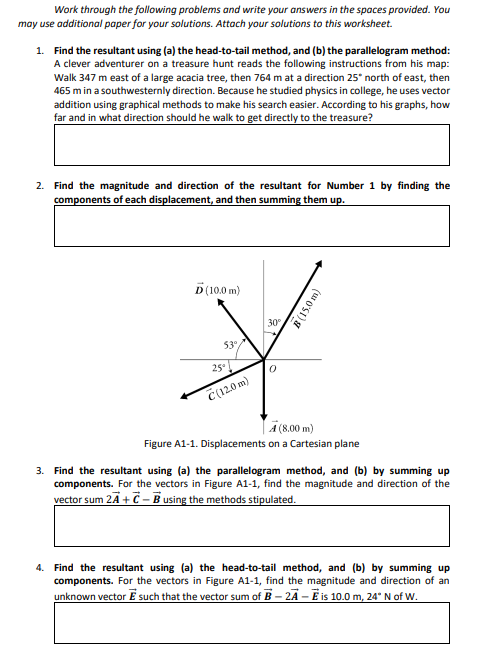University Physics Volume 1
18th Edition
ISBN:9781938168277
Author:William Moebs, Samuel J. Ling, Jeff Sanny
Publisher:William Moebs, Samuel J. Ling, Jeff Sanny
Chapter2: Vectors
Section: Chapter Questions
Problem 33P: A trapper walks a 5.0-km straigt4ine distance from his cabin to the lake, as shown in the following...
Related questions
Question

Transcribed Image Text:Work through the following problems and write your answers in the spaces provided. You
may use additional paper for your solutions. Attach your solutions to this worksheet.
1. Find the resultant using (a) the head-to-tail method, and (b) the parallelogram method:
A clever adventurer on a treasure hunt reads the following instructions from his map:
Walk 347 m east of a large acacia tree, then 764 m at a direction 25* north of east, then
465 m in a southwesternly direction. Because he studied physics in college, he uses vector
addition using graphical methods to make his search easier. According to his graphs, how
far and in what direction should he walk to get directly to the treasure?
2. Find the magnitude and direction of the resultant for Number 1 by finding the
components of each displacement, and then summing them up.
D(10.0 m)
30
53°
25°.
C(12.0 m)
| 4(8.00 m)
Figure A1-1. Displacements on a Cartesian plane
3. Find the resultant using (a) the parallelogram method, and (b) by summing up
components. For the vectors in Figure A1-1, find the magnitude and direction of the
vector sum 2A + C-B using the methods stipulated.
4. Find the resultant using (a) the head-to-tail method, and (b) by summing up
components. For the vectors in Figure A1-1, find the magnitude and direction of an
unknown vector E such that the vector sum of B – 2A - E is 10.0 m, 24° N of W.
B(15.0 m)
Expert Solution
This question has been solved!
Explore an expertly crafted, step-by-step solution for a thorough understanding of key concepts.
Step by step
Solved in 2 steps with 2 images

Knowledge Booster
Learn more about
Need a deep-dive on the concept behind this application? Look no further. Learn more about this topic, physics and related others by exploring similar questions and additional content below.Recommended textbooks for you

University Physics Volume 1
Physics
ISBN:
9781938168277
Author:
William Moebs, Samuel J. Ling, Jeff Sanny
Publisher:
OpenStax - Rice University

University Physics Volume 1
Physics
ISBN:
9781938168277
Author:
William Moebs, Samuel J. Ling, Jeff Sanny
Publisher:
OpenStax - Rice University